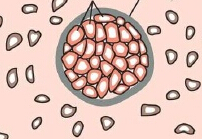When a person is diagnosed with a tumor, their first reaction is of shock and horror, and quite rightly so. But keep in mind that a tumor has the possibility of belonging to 2 types – malignant and benign. The differences between the two helps you better understand your prognosis as well as the necessary treatments required to improve your health.
What Does Benign Mean?
Basically, a benign tumor is noncancerous, and this distinction is important. Normally speaking, benign tumors are harmless and pose no threat to you or your health. They just remain in the same place and stop growing before becoming too large. Depending on its location, your prognosis could be very good and no surgery is needed. However, if its presence applies pressure on a main artery, primary nerve, or compresses brain matter, the condition is quite different.
Differences Between Benign and Malignant Tumors
After knowing the answer to “What does benign mean?” it’s helpful to understand the differences between the 2 kinds of tumors.
|
Benign Tumor
|
Malignant Tumor
|
|
Mass is able to move |
Mass is stationary |
|
Round and smooth, surrounded by a fibrous capsule. |
Can be of any shape and has no capsule surrounding it |
|
Cells multiply slowly |
Cells multiply quickly |
|
Growth happens via expansion or by pushing against surrounding tissue |
Growth occurs via the invasion and destruction of surrounding tissue |
|
Tumor is not attached to surrounding tissue |
Tumor is attached to surrounding tissue |
|
Stays in place and never spreads |
Will keep spreading if not removed |
|
Easy to remove and rarely comes back |
Difficult to remove and comes back after removal |
Common Types of Benign Tumors and Their Causes
Causes of Benign Tumors
Now that you know "What does benign mean?" you must also know there are many types of benign tumors. Science is yet to determine the actual reasons behind the formation of such tumors. Normally, when the old cells in our bodies die, they are replaced with new cells. But in some cases, the dead cells remain behind, forming what is called a tumor. They can also occur when the cells of our bodies keep multiplying at an extremely high rate.
Here are some factors which may lead to benign tumors:
- Genetics
- Local injury or trauma
- Environmental toxins such as exposure to radiation
- Stress
- Diet
- Infection or inflammation
Common Types of Benign Tumors
Now that you know the answer to the question “What does benign mean?” here is a list of the most common types of benign tumors and where they are generally found:
- Myomas (muscle tissue)
- Hemangiomas (skin and blood vessels)
- Neuromas (nerves)
- Lipomas (fat cells)
- Nevi (moles)
- Osteochondromas (bones)
- Fibromas or fibroids (most commonly found in the uterus but can also be found in connective tissues of any organ)
- Papillomas (cervix, skin, breast, and mucus membranes)
- Adenomas (epithelial tissue that covers the glands and organs)
- Meningiomas (spinal cord and brain)
How Are Benign Tumors Diagnosed?
There are many ways in which a diagnosis can be made about tumors, and all these diagnoses aim at knowing whether or not the tumor is benign. The first step begins with a physical examination by your doctor, as well as having an understanding of your medical history. Your doctor will question you about the symptoms you’re experiencing and you need to be as clear and honest to them as you possibly can. Also, know that it is only tests performed in laboratories that can determine the nature of your tumor.
- Imaging: Ultrasound, X-rays, CT and MRI scans can be ordered by your doctor to find out what is going on inside your body and have a better view of areas affected by the tumor.
- Biopsy: After the results of the imaging test are out, your doctor may order a biopsy to take a small sample of the tumor tissue. It is then taken to laboratory to undergo microscopic examination to determine the nature of the tumor.
- Blood test: If the biopsy result turns out to be cancerous, a blood test is sometimes performed to further look for the presence of certain cancer markers.
How to Deal With Benign Tumors
Now that you know "What does benign mean?" you’ll also know these tumors are mostly harmless. Treatment may not be required at all, depending on the size and location of the tumor. In such cases, your doctor will keep a regular track of your tumor and perform regular tests on it to monitor growth.
Treatment is required only when the symptoms are a problem, in which case surgery may be required to remove the tumor without making any damage to the surrounding tissues. Other methods of treatment include radiation therapy and medications.


